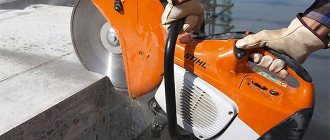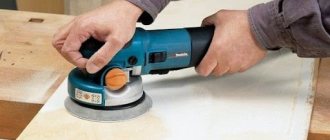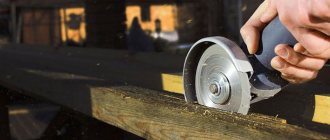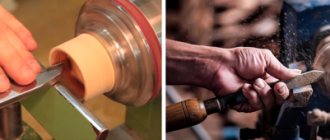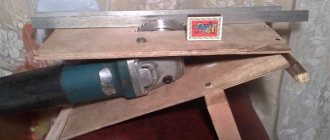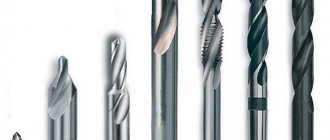An angle grinder, if you know and correctly use all its capabilities, is a truly universal device that can be used on almost any material. And if we are talking about processing wood on a large scale, then the “grinder” is much more effective than hand-held abrasive tools and devices. The main thing is to choose the right nozzle. This article will help you understand their main modifications and specific application.
Unwinding methods if the disk is jammed
What to do if the clamping flange is jammed? This trouble, when the nut is bitten, often occurs if, while working with thick and durable materials, the tool gets stuck in the workpiece. In this case, the abrasive wheel often breaks, and the spindle, which continues to rotate, tightly tightens the pressure flange. To unscrew the grinder if the disk is jammed, there are several ways.
Using a gas key
This method is considered not entirely safe, since the stopper can be broken, although in most cases it is possible to unscrew the nut. To avoid breaking the spindle lock, do not apply much force to the gas wrench. The design of the lock is designed to withstand the force applied by a standard wrench.
You can unscrew an overly tightened flange using 2 gas wrenches. To do this, break off the protruding ends of the abrasive wheel with pliers so that you can reach the lower flange with the first gas wrench. Next, clamp both flanges with keys and turn them in opposite directions (taking into account whether the thread on the spindle is right or left).
Disassembling the gearbox
If the lock is broken, you will have to disassemble the gearbox to remove the tool from the angle grinder. Use pliers to break off the edges of the remaining abrasive wheel so you can get to the bolts holding the gearbox cover in place. After this, unscrew the fasteners and open the gearbox. The cover will be removed along with the gear shaft. Next, this shaft should be clamped in a vice, having previously placed aluminum spacers between the steel jaws, and using a gas wrench, unscrew the flange (do not forget to determine the direction of unscrewing).
Nut heating
The nut can be heated using a gas burner, a hair dryer or a blowtorch. The heated flange can usually be unscrewed with a standard grinder wrench.
Grinding a jammed circle
If after using the first 3 methods the nut does not unscrew, then the remaining abrasive wheel between the flanges can be ground off. To do this, do the following.
- Use pliers to remove as much of the remaining circle around the edges of the nut as possible.
- Clamp a piece of sheet iron in a vice as thick as the disk itself, turn on the grinder and grind off the remaining circle on the end of the sheet iron.
But the use of a stationary abrasive wheel requires great care, because when grinding off the remains of the tool, the geometry of the flange can be damaged. If this happens, you will have to trim the nut.
Using Penetrating Lubricant
Liberally spray the flange/shaft joint with WD-40. It tends to penetrate into inter-threaded spaces and small cracks. After applying the liquid, wait about 5 minutes and try to unscrew the fasteners with a standard key.
Using a hammer drill
Some owners of grinders, in a situation where the clamping nut is jammed, install a “chisel” or “jackhammer” attachment in the hammer drill, insert it into the flange hole at an angle and turn on the jackhammer mode without rotation. Accordingly, the stop button must be pressed. Just a couple of gentle presses with a hammer drill are enough (so as not to break the shaft lock), and the nut will begin to turn.
Cut the pressure flange with a hacksaw
This method can be called radical, since you will have to buy new fasteners, and it is used if the nut cannot be unscrewed by any other methods. To cut the flange, hold the stop button to prevent the shaft from rotating and, using a hacksaw, cut the fastening nut.
Varieties
Grinding is the basic purpose of an angle grinder. In the case of working with wood, this is a complex process that requires care and skill from the master. Natural wood of varying structure is brought to perfection with high-quality and reliable discs. Regular diamond cutters will not work here. There are special grinding wheels for the woodworking industry.
There are several types of grinding wheels for angle grinders. First of all, the initial cleaning of surfaces is carried out. This work is performed by several disks, differing in shape and size.
- Roughing. They are designed to remove old paint and varnish from wood. Typically, remnants of the previous coating that cannot be cleaned by hand are removed from windows, window sills and floor surfaces. The disc is equipped with steel wire bristles for rough processing. The elastic bristles are placed either around the entire perimeter of the circle, that is, along, or at an angle segmentally, as in a regular brush. It depends on the purpose of the nozzle.
- Cord brushes with wire or spikes. They allow you to level and smooth the surface of any material. A wire brush can be used to easily remove a layer of varnish or old paint or rust from metal. If the boards on the floor are of different heights, they can be compared with each other using a tenon circle. They vary in shape and speed of rotation.
- End fittings. They work in layers, like files, with sides and edges, corners and oblique cuts. The attachments are designed for sanding edges or straightening bevels.
When sanding with a sander, the wood layer remains intact, only the decorative coating is removed. This property of the grinder is indispensable when restoring products. Having removed the previous colorful design, you can apply another one to the fresh and smooth panel. At the same time, the furniture will change its appearance and will look new. A brush is used to brush or artificially age the material. To do this, the soft fibers are removed to reveal the rings and grain of the natural wood. The stain emphasizes the relief transitions.
At the next stage of processing, the surface is smoothed. Here experts advise using polishing wheels. They are made of sponge, felt and coarse fabric, with replaceable sandpaper. Fabric and felt are secured for work using Velcro. The attachments are sold in sets of five for easy replacement. Sandpaper is selected with medium or fine grit. The brand is usually indicated on the packaging.
The design of the nozzle is also important. Lapping or finishing wheels are divided into petal, solid and movable. The use of a petal wheel allows you to achieve an absolutely smooth surface. Several layers of emery are placed on the disc as an abrasive, overlapping like fish scales. This arrangement of the abrasive material reduces wear. The product is brought to an ideal state by such a modern attachment as a cup circle. The bowl provides minor texturing and penetrates joints easily. It has a pile made of synthetic material or corrugated wire reinforced on it.
A nylon wood brush consists of a large number of small bristles. It is used for final polishing. The bowl-shaped attachment allows the craftsman to sand the most difficult to reach areas of the part. The brush removes burrs and minor dirt and polishes the varnish. End brushes are made of polymer abrasive, cylindrical brushes are made of brass and steel wire.
Sanding belt attachment
This additional device installed on the grinder allows you to sand hard-to-reach places on wooden, metal, stone and other objects.
The attachment is a narrow structure, with a handle and a base on which a sanding belt (sandpaper glued in a special way) is attached. This adapter connects to the grinder; the length of its working body is 115 mm.
The attachment is used for sanding structures with a lot of patterns, small parts and hard-to-reach small places. Also, it is effective for sharpening working and household tools - knives, scissors, shovels, axes.

